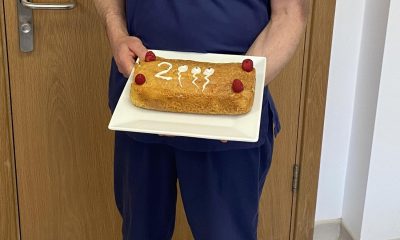By Mark Waghorn via SWNS
A brisk stroll just once a week could slash older women's risk of heart failure by a third, according to new research.
Those who walked at an average or quick pace were 27 and 34 percent less likely to develop the condition, respectively.
This was compared to postmenopausal peers who took a more casual approach.
The study was based on more than 25,000 individuals aged 50 to 79 tracked for an average of around 17 years.
What's more, health benefits of rapid steps were identified in participants who managed less than one hour a week.
They provided the same risk reduction as moving at average or casual speed for over twice that period.
via GIPHY
The former group went at more than 3mph and the latter at two to three or less than two, respectively.
Senior author Professor Charles Eaton, of Brown University, Rhode Island, said: "This study confirms other studies demonstrating the importance of walking speed on mortality and other cardiovascular outcomes.
"Given that limited time for exercise is frequently given as a barrier to regular physical activity, walking faster but for less time might provide similar health benefits as the recommended 150 minutes per week of moderate physical activity."
Your heart rate is elevated during fast walking. You burn more calories than walking at your usual pace.
About 6.2 million adults in the United States have heart failure, according to the CDC.
It mainly affects older people, causing breathlessness and fatigue - severely impairing quality of life.
The number of cases are expected to soar in the coming decades owing to the growing and aging population.
Prof Eaton said: "We still lack data defining the optimal lifestyle interventions to prevent heart failure.
"It has no effective therapy and is more common in women, older adults, and those with multiple comorbidities"
Physical activity is known to be protective but the role of specific types remains to be elucidated.
Prof Eaton said: "Walking, which essentially does not require any equipment, is the most common, especially for women and older adults."
It has been shown to lower death rates - in particular from diseases of the heart and circulatory system.
Prof Eaton said: "A few studies have evaluated walking pace independent of walking duration and found those with a faster walking pace had a lower risk of cardiovascular disease and all-cause mortality.
Slow walking pace may help geriatricians identify those at higher risk of heart failure.
They may benefit from targeted interventions to increase cardiorespiratory fitness and enhanced exercise tolerance, he said.
Fast walking may compensate for relatively shorter durations of walking with regard to the risk of incident heart failure
From a preventive viewpoint, the finding needs to be proven to be causal by randomized trials.
Prof Eaton added: "There will be an opportunity for those who do not have enough time or motivation to walk as long as the guidelines recommend to still reduce their risk by increasing their walking pace when capable of doing so."
At enrollment into the Women's Health Initiative in 1993 to 1998, the subset of participants were free of major disease.
Walking pace was self-reported. During the study period there were 1,455 heart failure hospitalization cases.

 Parenting1 week ago
Parenting1 week ago
 Lifestyle7 days ago
Lifestyle7 days ago
 Wildlife3 days ago
Wildlife3 days ago
 Good News4 days ago
Good News4 days ago
 Health4 days ago
Health4 days ago
 Broadcast1 week ago
Broadcast1 week ago
 Environment1 week ago
Environment1 week ago
 Work2 days ago
Work2 days ago






















